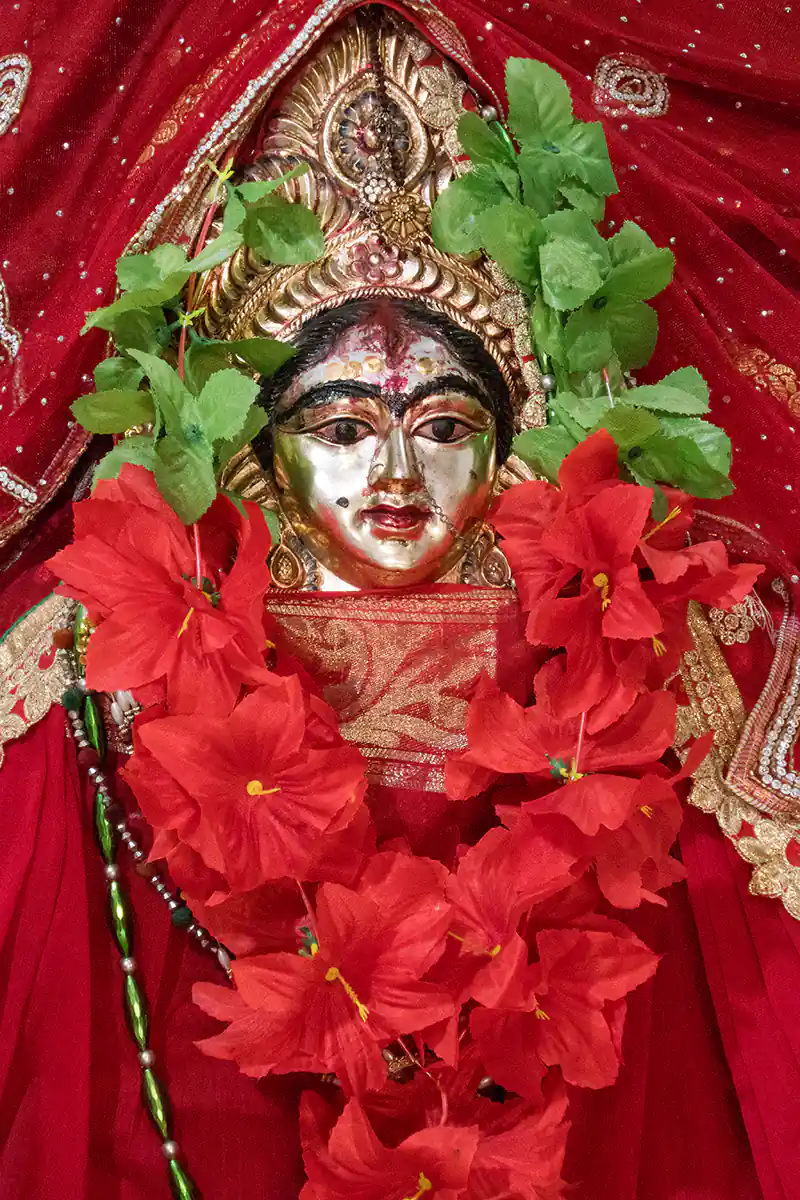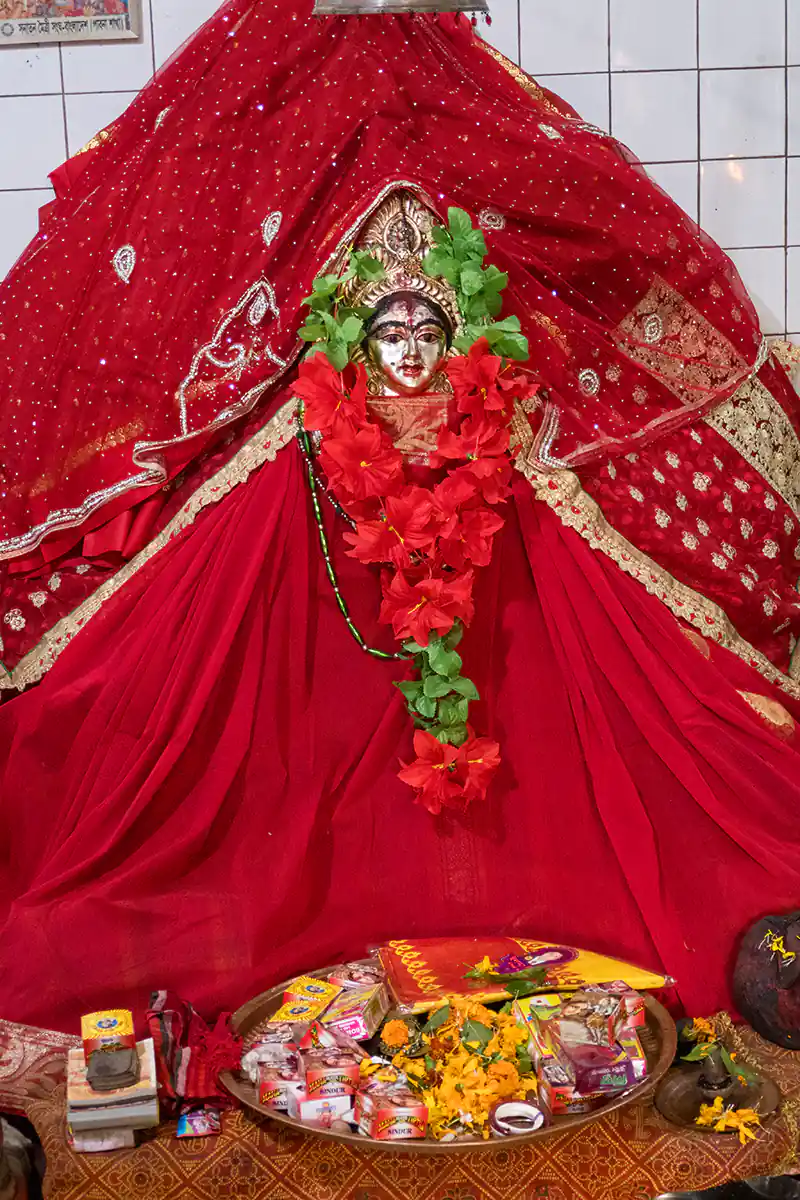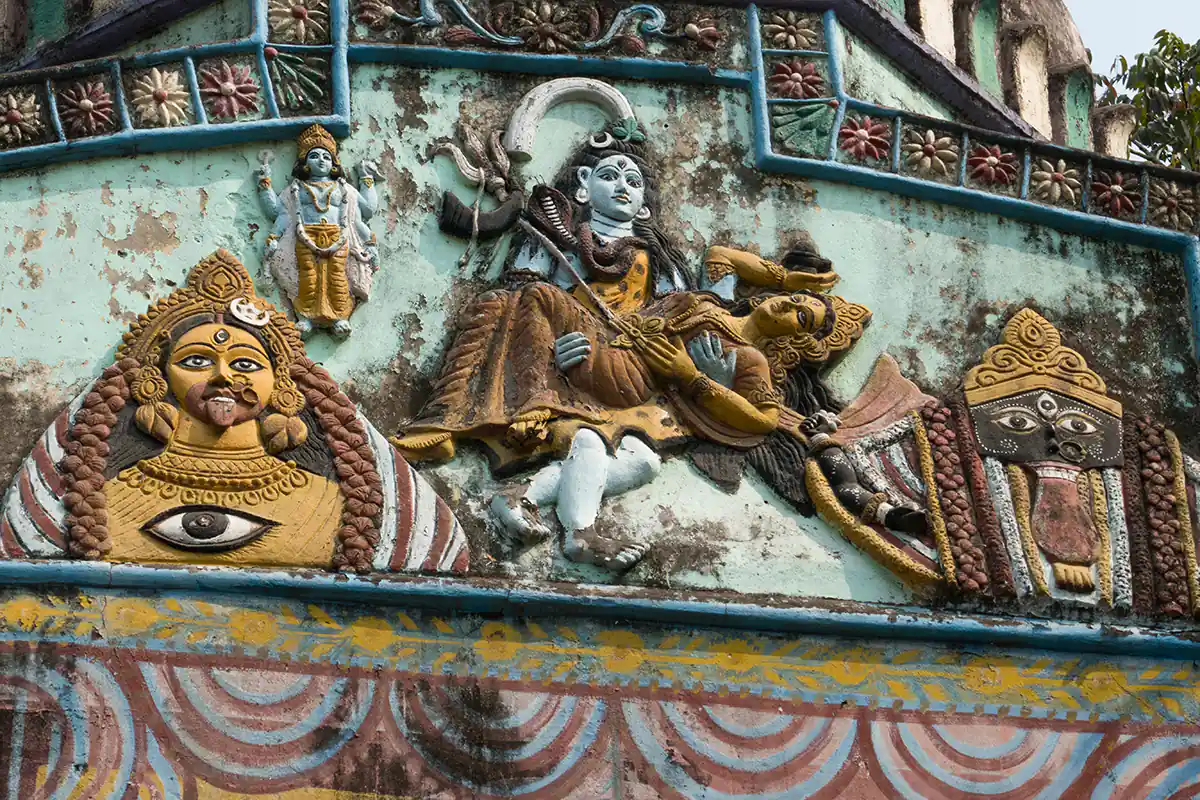Bhabanipur Shakti Pitha
Located approximately 20 miles south of the city of Bogra, the temple complex of Bhabanipur is one of the most visited Hindu pilgrimage sites in Bangladesh. Surrounded by a boundary wall and four acres in size, the complex features one of the five Shakti Pitha goddess sites in Bangladesh, several Shiva temples, and the holy Shakha-Pukur pond.
The Bhabanipur Shakti Pitha temple is dedicated to the goddess Bhabani, a form of the goddess Durga. It is said that Shakti's left ankle bracelet fell at this site, though some sources claim it was either her right eye or left ribs. The form of Shakti is alternately called Bhavani, Arpana, or Tara, and this deity has several associated legends. Etymologically, Bhavani means one who rules the universe, Arpana means one who is dedicated to Shiva, and Tara is said to be the most ferocious form of Durga.
A popular legend is associated with the holy Shakha Pukur pond. An itinerant jewelry salesman was passing near the temple when he met a small girl who purchased some bracelets for her wrists (conch bangles). Saying she was the daughter of the royal Rajshahi family, the girl instructed the seller to collect payment from Rani Bhavani, the Queen. When Rani Bhavani heard about this incident, she went to the pond, for there were no little girls in the royal family at that time.
She prayed to the goddess Bhabani, who then rose from the pond and wore the bracelets purchased by the young girl. An alternate version of the story tells that the Queen swam below the pond's surface, rising from the water with the bracelets on her wrists, leading those witnessing the event to declare her as divine. Devotees still immerse themselves in the Shakha-Pukur (conch-bangle) pond as part of their pilgrimage rituals.
The other four Shakti Pitha temples in Bangladesh are Jessoreswari at Ishwaripur, Chandranath at Sitakunda, Shri Shail at Joinpur, and Sugandha at Shikarpur.
The Shakti Pitha legend: healing sites of the goddess
The primary sacred places of the goddess in India are known as Shakti Pithas, and they are listed in different texts as being 4, 18, 51, or 108 in number, each of these sites being associated with a particular part of Shakti's body. A fascinating legend gives insight into the miraculous healing powers of the Shakti Pithas.
Shakti was the daughter of King Daksa and Queen Prasuti. She was also the wife of Shiva, whom King Daksa disliked for being a rough ascetic and for marrying Shakti against his wishes. King Daksa once held a great ceremony called a yagna, to which he invited neither his daughter nor son-in-law Shiva. Shakti was offended by this slight and attended the ceremony uninvited. Insulted by Daksa, she took her life by immolating herself in the ceremonial fire. On hearing this news, Shiva hastened to the house of Daksa, whom he decapitated, and then began to disrupt the ceremony and claim the body of his wife.
As the obstruction of the yagna ceremony would create havoc and severe ill effects on nature, the gods Brahma and Vishnu appealed to the grief-stricken Shiva, requesting that he permit the ceremony to be completed. Shiva complied and also affixed the head of the ram used in the ceremony to the decapitated body of Daksha. Returned to life, Daksha apologized to Shiva and begged for mercy from the Parabrahman (the Supreme Almighty who is formless), who informed him that Shiva was, in fact, a manifestation of Parabrahman. Daksha then became a great devotee of Shiva.
Still inconsolable at the loss of his beloved wife, however, Shiva placed her body on his shoulder and began the Tandava, a mad dance through the universe. To restrain Shiva and protect the universe from destruction, Vishnu threw his discus (or shot arrows in some accounts) to dismember the body of Shakti limb by limb (other sources say he entered Sati's body by yoga and cut the corpse into several pieces). When Shiva was deprived of the body, he ceased his mad dance. The parts of Shakti's body (or her jewelry) fell from Shiva's shoulders to the earth, and the places where they landed became the sites of the sacred Shakti Pitha shrines. For countless centuries, these sites have been visited by women having ailments in certain parts of their bodies - each temple enshrining a particular part of Shakti's body is believed to have the miraculous capacity to heal that same part of a woman's body. At all the Shakti Pitha temples, the Goddess Shakti is also accompanied by her consort, Lord Bhairava, a manifestation of Lord Shiva.
The geographical location of the Shakti Pitha temples is noteworthy. There is a considerably higher concentration of these temples in eastern India, particularly the northeast. Around forty percent of the temples are located in this region, which may perhaps be called the heart of the goddess cult in India. The history of the peopling of India suggests that the aboriginal population and their goddess cults moved further east following the Aryan invasion in the northwest starting in 1500 BCE, either being forcefully driven out or willingly migrating in search of safer places. Also notable is that most Shakti Pitha temples are closely associated with natural objects; most shrines occupy either hill or mountaintop locations or other elevated places.
Some scholars have noted that the 51 Shakti Pitha temples may be linked to the 51 letters in the Sanskrit alphabet. Another series of 108 shrines of the goddess is mentioned in the texts, and they have significant symbolic importance in Vedic astronomical and astrological systems. The number 108 is the product of 12 months and 9 zodiacs, the product of 36 varieties of divinities and 3 mythical realms, and the product of 27 lunar mansions and 4 directions.
The names and locations of the Shakti Pithas may be found on these Wikipedia and Temple Purohit pages. Readers interested in learning more about these places can consult books by Bagchi, Housden, Morinis, Sastri, and Sircar, which are listed in the bibliography. A list of the 51 Shakti Pithas is given in Travels through Sacred India by Roger Housden, and directions to the shrines may be found in the guidebook entitled India: A Practical Guide, by John Howley.
Listing and locations of Shakti Pitha sites:

Martin Gray is a cultural anthropologist, writer and photographer specializing in the study of pilgrimage traditions and sacred sites around the world. During a 40 year period he has visited more than 2000 pilgrimage places in 160 countries. The World Pilgrimage Guide at sacredsites.com is the most comprehensive source of information on this subject.



